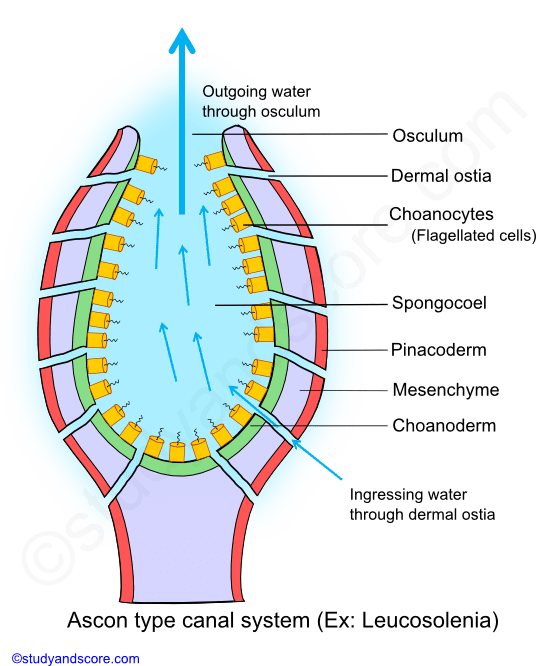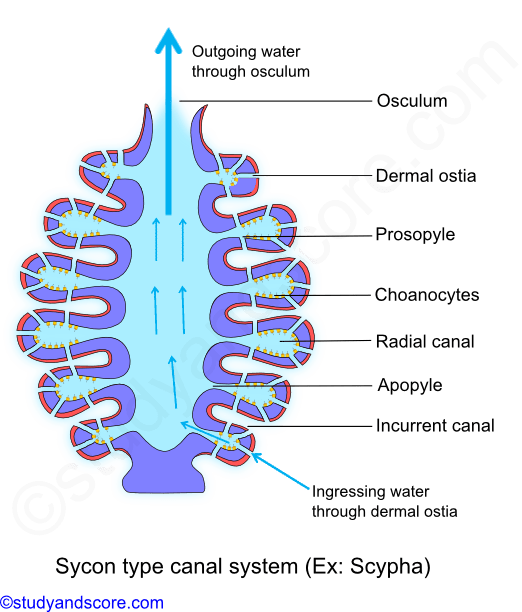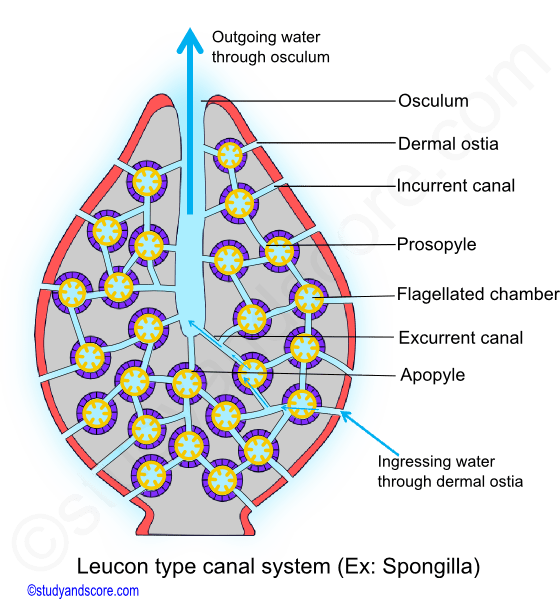The water circulatory system of sponges also called as canal system is the characteristic feature of the phylum Porifera. Canal system is also known as aquiferous system. The canal system of sponges helps in food acquisition, respiratory gas exchange and also in excretion.
The numerous perforations on the body surface of the sponges for ingression and egression of water current are the main constituents of the canal system. Inside the body, the water current flows through a certain system of spaces where by the food is captured from the incoming water and the excretory material is sent out into the outgoing water.
Water current plays the most vital role in the physiology of the sponges. The body wall of the sponges consists of two epitheloid layers the outer pinacoderm and the inner choanoderm. Pinacoderm consists of porocytes cells which bear openings called ostia. Choanoderm is composed of choanocytes or collar cells. The choanocytes have collar of microvilli around the flagellum. The water current is caused by beating of flagella of the collar cells. The following are the functions of the water current which enters the body of the sponges through the canal system:
Different sponges have different arrangement and grades of complexity of internal channels and accordingly the canal system is been divided into the following three types:
This canal system is the simples of all the three. It is found in asconoid type of sponges like Leucosolenia and also in some of the developmental stages of all the syconoid sponges.
The body surface of the asconoid type of sponges is pierced by a large number of minute openings called as incurrent pores or ostia. These pores are intracellular spaces within the tube like cells called porocytes. These pores extend radially into mesenchyme and open directly into the spongocoel.
The spongocoel is the single largest spacious cavity in the body of the sponge. The spongocoel is lined by the flattened collar cells or choanocytes. Spongocoel opens outside through a narrow circular opening called as osculum located at the distal end and it is fringed with large monaxon spicules.
The surrounding sea water enters the canal system through the ostia. The flow of the water is maintained by the beating of the flagella of the collar cells. The rate of water flow is slow as the large spongocoel contains much water which cannot be pumped out through a single osculum.
Ingressing water Ostia Spongocoel Osculum outside

Sycon type of canal system is more complex compared to the ascon type. This type of canal system is the characteristic of syconoid sponges like Scypha. Theoretically this canal system can be derived from asconoid type by horizontal folding of its walls. Also embryonic development of Scypha clearly shows the asconoid pattern being converted into syconoid pattern.
Body walls of syconoid sponges include two types of canals, the radial canals and the incurrent canals paralleling and alternating with each other. Both these canals blindly end into the body wall but are interconnected by minute pores. Incurrent pores also known as dermal ostia are found on the outer surface of the body. These incurrent pores open into incurrent canals.
The incurrent canals are non-flagellated as they are lined by pinacocytes and not choanocytes. The incurrent canals leas into adjacent radial canals through the minute openings called prosopyles. On the other hand radial canals are flagellated as they are lined by choanocytes. These canals open into the central spongocoel by internal ostia or apopyles.
In sycon type of canal system, spongocoel is a narrow, non-flagellated cavity lined by pinacocytes. It opens to the exterior though an excurrent opening called osculum which is similar to that of the ascon type of canal system.
Ingressing water dermal ostia incurrent canal Prosopyles Radial canals Apopyles Spongocoel Osculum Outside

Sycon canal system takes a more complex form in few species like Grantia, where the incurrent canals are irregular and branching forming large sub-dermal spaces. This is due to the development of cortex, involving pinacoderm and mesenchyme spreading over the entire outer surface of sponge.
This type of canal system results due to further folding of body wall of the sycon type of canal system. This canal system is the characteristic of the leuconoid type of sponges like Spongilla. In this type the radial symmetry is lost due to the complexity of the canal system and this result in an irregular symmetry.
The flagellated chambers are small compared to that of the asconoid and syconoid type. These chambers are lined by choanocytes and are spherical in shape. All other spaces are lined by pinacocytes. The incurrent canals open into flagellated chambers through prosopyles. These flagellated chambers in turn communicate with the excurrent canals through apopyles. The excurrent canals develop as a result of shrinkage and division of spongocoel. The large and spacious spongocoel which is present in the asconoid and syconoid type of canal systems is absent here. Here the spongocoel is much reduced. This excurrent canal finally communicates with the outside through the osculum.
Ingressing water dermal ostia incurrent canal Prosopyles Flagellated chambers Apopyles excurrent canals Osculum Outside

Leucon type of canal system has the following three successive grades in its evolutionary pattern:
Eurypylous type: This is the simplest and the most primitive type of leuconoid canal system. In this type the flagellated chambers directly communicate with the excurrent canal through broad apertures called the apopyles.
Ex: Plakina
Aphodal type: In this type of canal system the apopyles are drawn out as a narrow canal called aphodas. This connects the flagellated chambers with the excurrent canals.
Ex: Geodia
Diplodal type: in some of the sponges, along with aphodas another narrow tube called prosodus is present between incurrent canal and flagellated chamber. This arrangement gives rise to diplodal type of canal system.
Ex: Spongilla

- Share with your friends! -
Login to post your comment here...
- or with social Account -